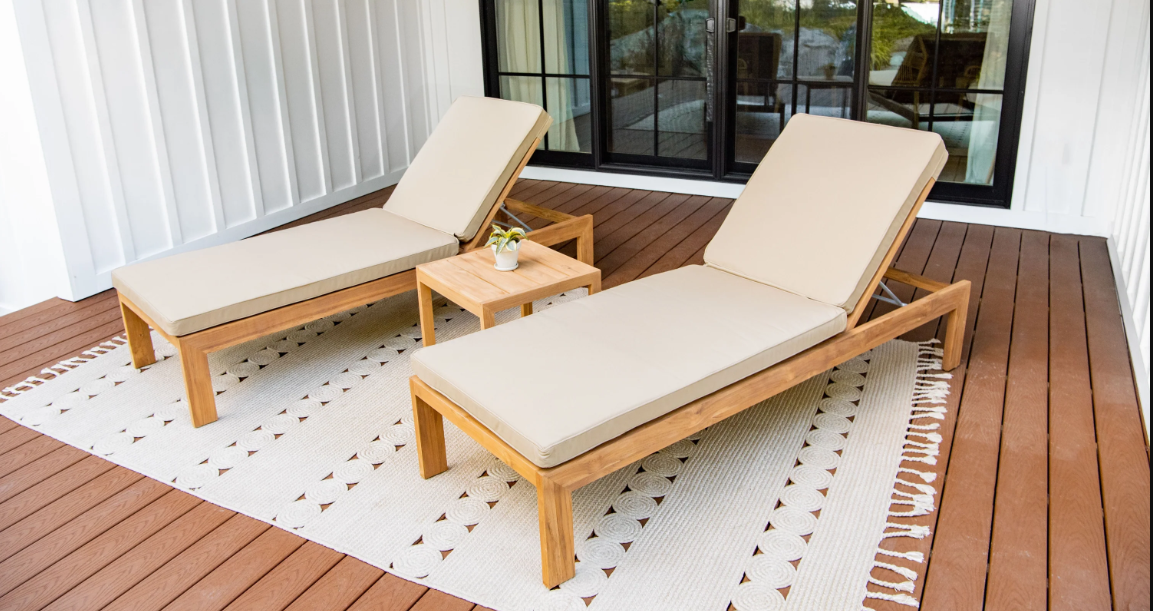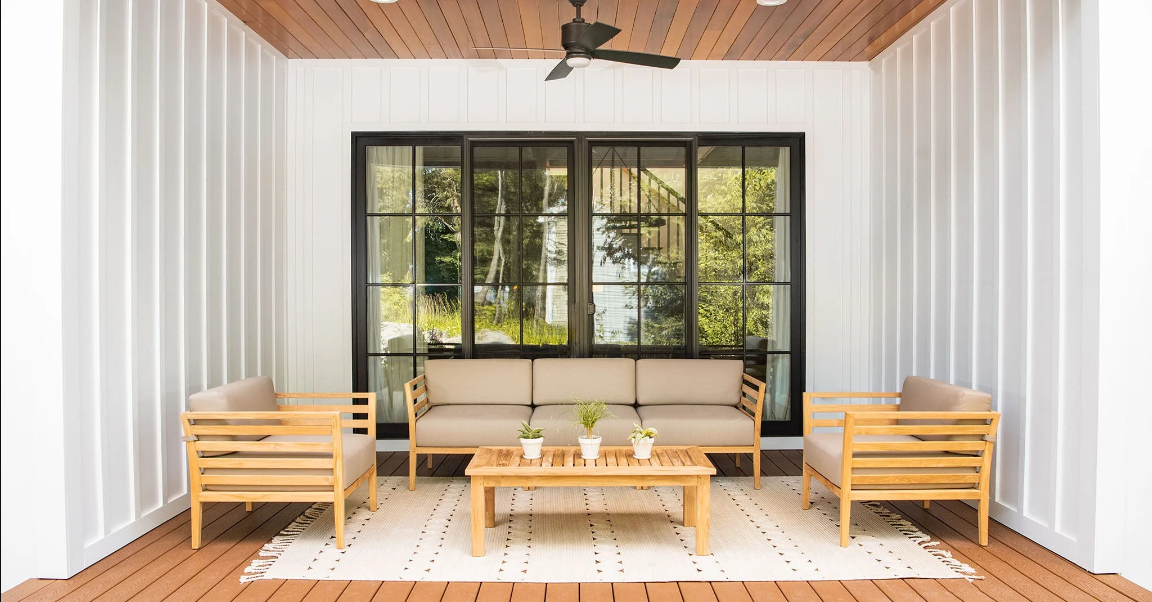
Furniture connoisseurs and woodworking enthusiasts will tell you that teak wood holds prestige. Prized for its remarkable durability and exquisite beauty, this tropical hardwood is often the material of choice for high-quality outdoor furniture. But what exactly sets teak wood apart? And how do you ensure you’re investing in genuine teak rather than falling for a cheap imitation? Enter the wonderful world of teak wood, and let’s uncover the secrets that make it so coveted, including “how to identify teak wood key tips for recognizing this premium timber.”
Key Takeaways
-
Teak wood is characterized by its golden brown hue, straight and smooth grain pattern, notable density and heaviness, and high oil content for weather resistance.
-
Identifying real teak wood requires knowing telltale signs such as a distinctive leather-like smell or water absorption test.
-
Madbury Road offers the highest quality ethically sourced teak furniture with long-lasting durability for outdoor use.
The Key Characteristics of Genuine Teak Wood
Teak wood’s distinction lies in its defining characteristics, which govern its quality and durability. The color, grain pattern, weight, and natural oil content combine to make teak wood a prime choice for furniture. The rich golden brown hue is one of the first to catch the eye. This is complemented by a straight and smooth grain pattern, adding to the wood’s aesthetic appeal.
Teak wood’s appeal is further enhanced by its notable density and heaviness resulting from its small pores and high oil content. Besides giving the wood its weight, these natural oils offer protective properties that render teak wood perfect for outdoor furniture.
Color: Golden Brown to Dark Brown
The color of teak wood is typically a beautiful honey brown that can darken over time. This color variation can be attributed to several factors, including tree age, soil composition, and exposure to sunlight. For instance, freshly planed teak wood tends to have a light, golden brown color, which darkens to a rich brown hue as it ages.
The growth region also impacts the shade of teak wood. For example, teak from Indonesia generally exhibits a light-brown color with a slight grey tinge.
Grain Pattern: Straight and Smooth
Another notable characteristic of high-quality teak wood is its straight and smooth grain pattern. This pattern contributes to the wood’s strength and durability and enhances its aesthetics, making it a popular choice for furniture. The grain pattern can be influenced by factors such as tree age and growth performance in different regions, making each piece of teak furniture unique.
Furthermore, the dense grain structure of teak wood contributes to its weather resistance and reduces the likelihood of cracking and warping.
Weight: Heavy and Dense
The weight of teak wood serves as another crucial authenticity indicator. Genuine teak is heavy and dense, thanks mainly to its small pores and high oil content. On average, teak wood weighs between 25 and 70 pounds per cubic foot, making it heavier and denser than many other wood species.
The compact structure and reduced empty space within the wood, provided by its small pores, yield a denser and heavier material.
Natural Oil Content: High and Protective
The natural oil content in teak wood is high, contributing significantly to its protective properties. These oils serve as a natural shield against:
-
Moisture inhibits water from permeating the wood and inducing deterioration
-
Insects, repelling them and guarding against infestation
-
Rot makes teak wood remarkably resistant to water, insects, and rot.
Beyond that, the natural oils in teak wood are integral to preserving its longevity, nourishing the wood, and preventing decay.
Identifying Real vs. Fake Teak Wood: Telltale Signs

In a marketplace where imitation is rife, distinguishing between real and fake teak wood is essential. Certain telltale signs can help you identify genuine teak wood. These include the distinctive leather-like aroma, the water absorption test, and the inspection of the furniture’s construction and joints.
With a discerning eye and some knowledge, you can make informed decisions and guarantee an authentic teak wood investment.
Distinctive Leather-like Smell
Teak wood’s distinctive leather-like aroma is a clear sign of its authenticity. This unique aroma is due to the high oil content in the wood. Freshly cut teak wood or wood with more natural oil gives off this distinctive scent. However, the scent may become less potent as the wood ages and the oil fades.
Water Absorption Test
The water absorption test offers another method to recognize genuine teak wood. Real teak wood absorbs less water than fake or lower-grade wood due to its high oil content, which repels water.
The water absorption test is a useful tool in identifying the quality and authenticity of teak wood, helping you ensure that your investment is worthwhile.
Construction and Joints
The furniture’s construction and joints also serve as clear indicators of teak wood’s authenticity. High-quality teak furniture typically features strong, secure joints made using mortise and tenon joinery, renowned for its strength and durability.
Conversely, furniture made from fake teak wood may have poorly constructed joints, uneven or unsteady joints, or weak connections between components.
Types and Grades of Teak Wood

Teak wood is not a one-size-fits-all material. It comes in various types and grades, each with distinct characteristics and qualities. These include:
-
Grade A teak
-
Grade B teak
-
Grade C teak
-
Burma teak
-
Indonesian teak
-
Southern American teak
Grasping these variations aids in a better assessment of teak wood’s quality and authenticity.
Grade A Teak
Grade A teak is considered the highest quality of teak wood. It is derived from the inner sections of the teak tree and features a straight grain, deep color, and high oil content. This teak wood grade is highly sought after for durability, strength, and beauty.
With time, Grade A teak wood acquires a striking silvery-grey patina, enhancing its charm.
Grade B and C Teak
Compared to Grade A, Grades B and C teak are of lower quality. Grade B teak is sourced from the outer sections of the teak tree and has a slightly uneven grain and less luster. Grade C teak comes from the outermost section of the tree, known as the sapwood, and has more blemishes and a lower oil content. Understanding these differences can help you make an informed decision when purchasing teak wood furniture.
Regional Varieties: Burma, Indonesian, and Southern American Teak
The growth region can also influence the characteristics of teak wood. Burma teak is desirable for its uniform golden brown color without markings and a feeling of oiliness to the touch. Indonesian teak resembles Burmese but often finishes with a lighter, honey-colored stain.
On the other hand, Southern American teak is distinct from Burmese and Indonesian teak, offering unique qualities that make it a desirable choice for certain applications.
Teak Wood in Outdoor Furniture: Benefits and Considerations

The distinctive characteristics of teak wood render it a perfect choice for outdoor furniture. It’s not just about the aesthetic appeal but also the practical benefits it offers.
Teak wood’s weather resistance, durability, and low maintenance requirements make plantation teak a valuable investment for outdoor teak furniture, providing long-lasting beauty and functionality while maintaining a light teak furniture appearance.
Weather Resistance
The high oil content in teak wood naturally equips it to resist various weather conditions. Teak wood holds its ground whether exposed to rain, hail, wind, or the burning sun.
This weather resistance makes teak wood an excellent choice for outdoor furniture, poolside lounges, patio dining sets, or garden benches.
Durability and Longevity
In addition to its weather resistance, teak wood is exceptionally durable and long-lasting. It is resistant to decay, termites, and other pests, making it a worthwhile investment for outdoor furniture.
Proper maintenance ensures outdoor furniture made from teak wood can last 25 to 30 years.
Maintenance Tips
Maintaining teak wood furniture is relatively easy due to its natural resistance to common issues like rot and pests. Here are some tips to keep your teak furniture looking its best:
-
Regularly clean the furniture with a soft-bristled brush and mild soap.
-
Avoid placing the furniture in direct sunlight to prevent fading.
-
Cover the furniture during harsh weather conditions to protect it from damage.
Following these tips can help extend the lifespan of your teak furniture.
Ethical Harvesting and Sustainability
The allure of teak wood comes with a responsibility to the environment. When sourcing teak wood, ethical harvesting, and sustainability remain vital considerations. Responsible sourcing not only helps prevent deforestation but also promotes eco-friendly practices.
Hence, when purchasing teak wood, it’s important to consider the source and ensure it adheres to sustainable harvesting practices.
How Madbury Road Can Provide You The Best Teak Wood
Selecting the appropriate supplier is vital to guarantee the quality of your teak wood furniture. Madbury Road is committed to providing customers with high-quality teak wood furniture from ethically sourced and sustainable materials.
Their range of indoor and outdoor furniture embodies excellence in design and emphasizes environmental responsibility in their garden furniture selection. Get your teak wood at Madbury Road Today!
Summary
In conclusion, the unique characteristics of teak wood, including its color, grain pattern, weight, and natural oil content, make it a highly desirable material for outdoor furniture. Its weather resistance, durability, and longevity further enhance its appeal.
However, ensuring that the teak wood you purchase is genuine and ethically sourced is vital. By doing so, you’re investing in a piece of timeless beauty and contributing to the sustainability of our planet’s resources.
Frequently Asked Questions
How do you identify teak wood?
To identify teak wood, look for wood with a straight grain, natural oil content, density and weight, and distinct fragrance. Its oil makes it resistant to water, bacteria, and pests.
What features does teak timber have?
Teak timber is known for its high durability, weight, and resistance to decay and acid, making it an excellent choice for indoor and outdoor furniture and ship decks.
How do you tell the grade of teak?
The grade of teak is determined by where the wood comes from on the tree, with A grade typically being found in the heartwood and having a honey-like complexion and lesser grades being reddish or dark brown.
How can I tell if my teak wood furniture is genuine?
To determine whether your teak wood furniture is genuine, check for a leather-like smell, perform a water absorption test, and inspect the construction and joints.
Why is teak wood ideal for outdoor furniture?
Teak wood's weather resistance, durability, and low maintenance requirements make it ideal for outdoor furniture.

